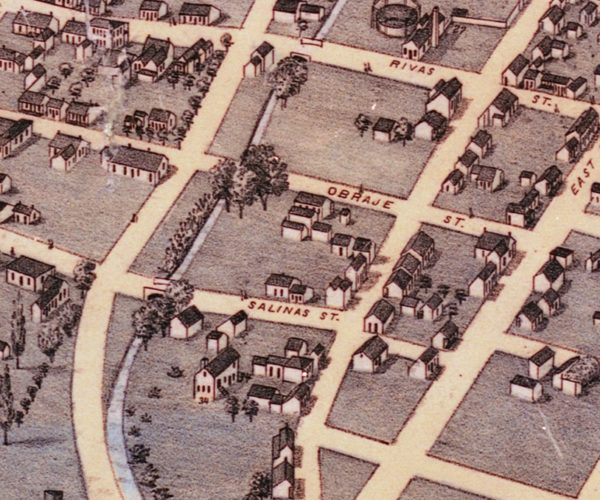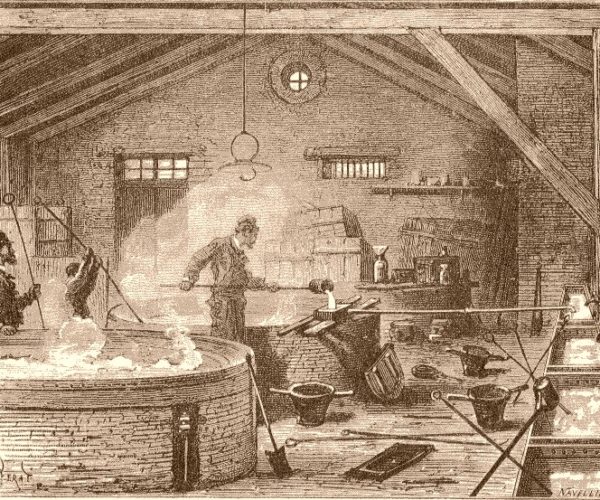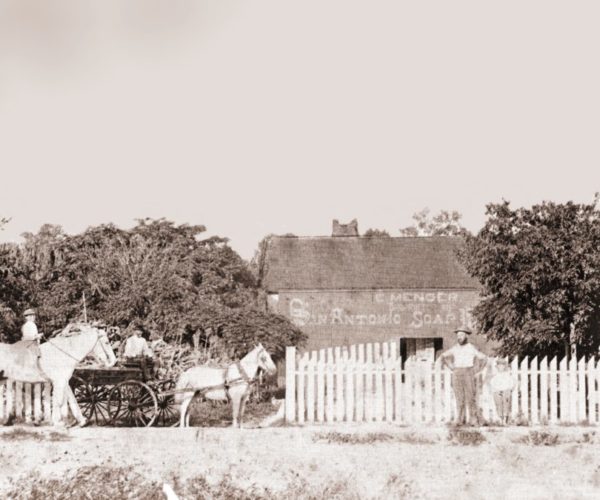These ancient waters also served as a resource for San Antonio’s first entrepreneurs and aspiring industrialists.
San Pedro Creek was an invaluable source of water for residents who lived and farmed and grazed their livestock along its banks. The creek also provided water for businesses that manufactured a variety of products for the local market. The ingenious German immigrant Simon Menger, a music teacher by profession, purchased a soap-making business on the creek south of this site in 1851. He expanded the facility and advertised himself as a “manufacturer of soap, tallow candles and vinegar.” After his factory was badly damaged by a flood in 1859, Menger began purchasing property further upstream and reestablished his business here on the west bank of San Pedro Creek. Simon and Augusta Louise Menger raised their family in the home they built adjoining the factory. S. Menger and Sons, later known as the San Antonio Soap Works, manufactured products for household and commercial uses and by the late 1870s sold over 25,000 pounds of soap per month.
As their father grew older, Erich Menger managed the San Antonio business and August oversaw a branch factory in Houston. Erich purchased the soap works in 1882 and continued operating the business here until the early 1900s. The building was later used as a broom factory, printing shop, and apartments. Like other landmarks of early city history, the soap works was abandoned to decades of disuse. After surviving years of neglect, it was eventually threatened with demolition by the Urban Renewal program, only to be saved by the San Antonio Conservation Society in 1970. This historic structure, San Antonio’s earliest remaining industrial building, was restored and incorporated into the nearby Soap Works Apartment complex. Part of the creek’s long history lives within its walls.
Estas aguas antiguas también fueron un recurso para los primeros empresarios y aspirantes de la industria en San Antonio.
El Arroyo San Pedro era una fuente de agua invaluable para los residentes que vivían, cultivaban y alimentaban su ganado a lo largo de sus orillas. El arroyo también proporcionó agua para las empresas que fabricaban una amplia variedad de productos para el mercado local. En 1851, el ingenioso inmigrante alemán Simon Menger, profesor de música de profesión, compró un negocio de fabricación de jabón localizado en el arroyo, al sur de este sitio. Expandió las instalaciones y se hizo publicidad a sí mismo como un “fabricante de jabón, velas de sebo y vinagre”. Después de que su fábrica resultara gravemente dañada por una inundación en 1859, Menger comenzó a comprar propiedades aguas arriba y estableció su nuevo negocio aquí, en la ribera occidental del Arroyo San Pedro. Simon y Augusta Louise Menger criaron a su familia en la casa que construyeron contigua a la fábrica. S. Menger and Sons, más tarde conocida como San Antonio Soap Works, fabricaba productos para uso doméstico y comercial y para fines de la década de 1870, vendía más de 25,000 libras de jabón por mes.
A medida que su padre iba envejeciendo, Erich Menger administró el negocio de San Antonio y August supervisó una segunda fábrica en Houston. Erich compró las fábricas de jabón en 1882 y continuó operando el negocio hasta principios del siglo XX. El edificio fue utilizado más tarde como una fábrica de escobas, imprenta y apartamentos. Al igual que otros edificios emblemáticos de la historia temprana de la ciudad, las fábricas de jabón fueron abandonadas y sufrieron décadas de abandono. Después de sobrevivir años de negligencia, fueron eventualmente amenazadas con la demolición por el programa de Renovación Urbana, solo para ser salvadas por la Sociedad de Conservación de San Antonio en 1970. Esta estructura histórica, el primer edificio industrial de San Antonio que sobrevive, fue restaurada e incorporada al cercano complejo de apartamentos Soap Works. Parte de la larga historia del arroyo vive dentro de sus muros.





